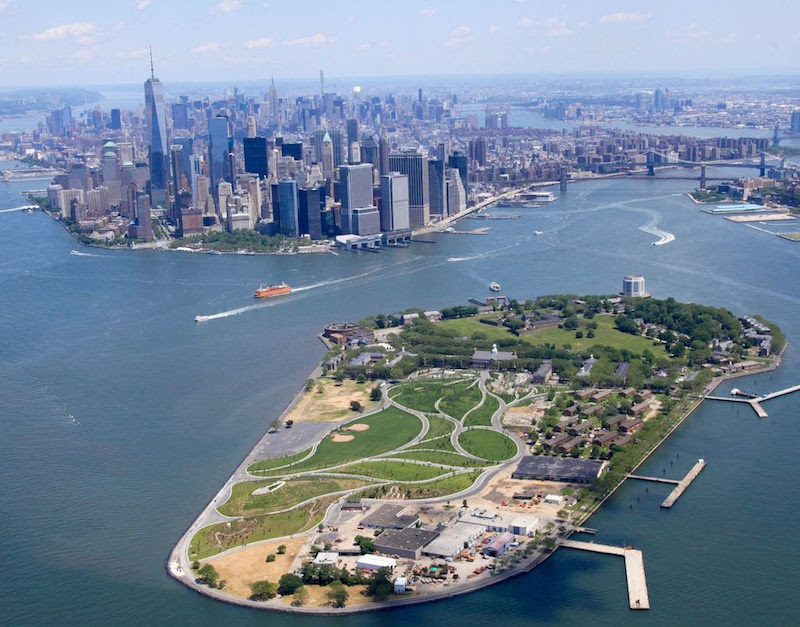Rising between 25 and 70 feet above sea level, four man-made hills on the southern tip of New York City’s Governors Island opened to the public in July, one full year ahead of schedule. Dubbed The Hills, the new attraction boasts walking paths, recreational opportunities, and full 360-degree vistas of New York Harbor. And while the Hills offer strong aesthetic value and public space for outdoor activities, they also provide a resiliency measure to protect the island against rising sea levels.
The first phase of construction for the island, which can only be accessed by ferry, was completed in 2014 and consisted of 30 new acres of park and public spaces; an upgrade to Soissons Dock, the only vehicular landing on the island; transfer bridges and approach platforms at the dock; reconstruction of the seawall and the island’s drainage system; restoration of potable water and electrical distribution systems; and stabilization of historic buildings.
As part of a joint venture, STV is providing resident engineering inspection and design review services for the implementation of the Governors Island Park and Public Space Master Plan. In addition to changing 10 acres of flat land into rolling hills that would have Julie Andrews singing like it was 1965, the island’s Master Plan also calls for over 75,000 new plantings, which includes 42,963 shrubs and 2,960 trees.
In creating the hills, STV saved in construction costs by using terraced, mechanically stabilized earth and lightweight fill rather than going the more traditional route using deep soil mixing methods. In addition to the monetary savings, this method also reduced the overall weight on the underground utilities and sea well.
Included in the four hills are Grassy Hill, which is the first to be seen when approaching from the park; Slide Hill, which includes four slides built into the hill itself, including a 57-foot long slide that is the longest in New York City; Outlook Hill, which features “The Scramble,” a shortcut cutting straight up the hill constructed from blocks of granite from the seawall the Army placed in the harbor when they expanded the island in 1905; and Discovery Hill, which features a site-specific work of art from British artist Rachel Whiteread.
With The Hills completed, the next step of the Master Plan for Governors Island calls for improvements to Picnic Point and the 2.2 mile promenade.
West 8 provided design services for the island’s transformation.
Related Stories
| Nov 3, 2010
Sailing center sets course for energy efficiency, sustainability
The Milwaukee (Wis.) Community Sailing Center’s new facility on Lake Michigan counts a geothermal heating and cooling system among its sustainable features. The facility was designed for the nonprofit instructional sailing organization with energy efficiency and low operating costs in mind.
| Nov 3, 2010
Recreation center targets student health, earns LEED Platinum
Not only is the student recreation center at the University of Arizona, Tucson, the hub of student life but its new 54,000-sf addition is also super-green, having recently attained LEED Platinum certification.
| Oct 13, 2010
New health center to focus on education and awareness
Construction is getting pumped up at the new Anschutz Health and Wellness Center at the University of Colorado, Denver. The four-story, 94,000-sf building will focus on healthy lifestyles and disease prevention.
| Oct 13, 2010
Community center under way in NYC seeks LEED Platinum
A curving, 550-foot-long glass arcade dubbed the “Wall of Light” is the standout architectural and sustainable feature of the Battery Park City Community Center, a 60,000-sf complex located in a two-tower residential Lower Manhattan complex. Hanrahan Meyers Architects designed the glass arcade to act as a passive energy system, bringing natural light into all interior spaces.
| Oct 13, 2010
Community college plans new campus building
Construction is moving along on Hudson County Community College’s North Hudson Campus Center in Union City, N.J. The seven-story, 92,000-sf building will be the first higher education facility in the city.
| Oct 12, 2010
Owen Hall, Michigan State University, East Lansing, Mich.
27th Annual Reconstruction Awards—Silver Award. Officials at Michigan State University’s East Lansing Campus were concerned that Owen Hall, a mid-20th-century residence facility, was no longer attracting much interest from its target audience, graduate and international students.
| Oct 12, 2010
Building 13 Naval Station, Great Lakes, Ill.
27th Annual Reconstruction Awards—Gold Award. Designed by Chicago architect Jarvis Hunt and constructed in 1903, Building 13 is one of 39 structures within the Great Lakes Historic District at Naval Station Great Lakes, Ill.
| Sep 16, 2010
Green recreation/wellness center targets physical, environmental health
The 151,000-sf recreation and wellness center at California State University’s Sacramento campus, called the WELL (for “wellness, education, leisure, lifestyle”), has a fitness center, café, indoor track, gymnasium, racquetball courts, educational and counseling space, the largest rock climbing wall in the CSU system.
| Sep 13, 2010
Stadium Scores Big with Cowboys' Fans
Jerry Jones, controversial billionaire owner of the Dallas Cowboys, wanted the team's new stadium in Arlington, Texas, to really amp up the fan experience. The organization spent $1.2 billion building a massive three-million-sf arena that seats 80,000 (with room for another 20,000) and has more than 300 private suites, some at field level-a first for an NFL stadium.
| Aug 11, 2010
JE Dunn, Balfour Beatty among country's biggest institutional building contractors, according to BD+C's Giants 300 report
A ranking of the Top 50 Institutional Contractors based on Building Design+Construction's 2009 Giants 300 survey. For more Giants 300 rankings, visit http://www.BDCnetwork.com/Giants
















